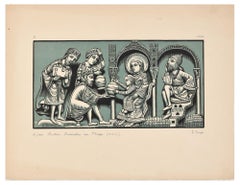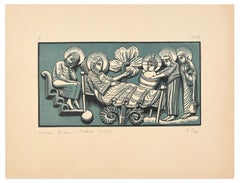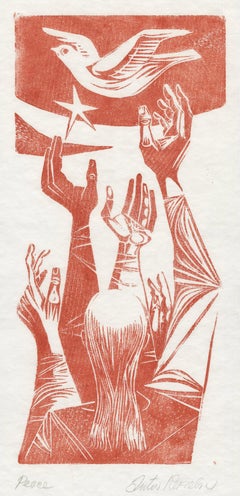Isidore Sage Art
to
2
Overall Width
to
Overall Height
to
2
2
2
2
2
2
1
1
1
1
2
2
9,478
2,688
1,375
1,361
Artist: Isidore Sage
Adoration des Mages - Original Woodcut Print by I. Sage - 1926
By Isidore Sage
Located in Roma, IT
Adoration des Mages is an original artwork realized by Isidore Sage in the first decades in 1926.
Original colored xylograph on paper.
Image dimensions: 13 x 24 cm.
Titled and numbe...
Category
1920s Modern Isidore Sage Art
Materials
Woodcut
Nativité - Original Woodcut Print by I. Sage - 1927
By Isidore Sage
Located in Roma, IT
Nativité is an original artwork realized by Isidore Sage in 1927.
Original Xilograph on paper.
Hand-signed in pencil on the lower right: I. Sage; titled and numbered on the lower...
Category
1920s Modern Isidore Sage Art
Materials
Woodcut
Related Items
Wedding Party
Located in Buffalo, NY
An original mid century modern woodblock print.
This work is hand signed illegibly and titled "Wedding Party".
Category
1960s Modern Isidore Sage Art
Materials
Paper, Woodcut
Peace
By Anton Refregier
Located in Fairlawn, OH
Peace
Woodcut printed in orange red ink on japanese paper
Signed and titled in pencil lower right (see photo)
Titled lower left (see photo)
Created along with an illustrated book project Song of Peace, 1950-1959.
Condition: Excellent
Image: 10 1/2 x 4 7/8"
Sheet: 16 1/8 x 7";
Anton Refregier (March 20, 1905 – October 10, 1979) was a painter and muralist active in Works Progress Administration Federal Art Project commissions, and in teaching art. He was a Russian immigrant to the United States.
Among his best-known works is his mural series The History of San Francisco, located in the Rincon Center in downtown San Francisco, California. It depicts the city's history across twenty seven panels that he painted from 1940 to 1948.
Life and early career
Refregier was born in Moscow and emigrated to the United States in 1920. After working various odd jobs in New York City, he earned a scholarship to the Rhode Island School of Design in 1921. After finishing school, Refregier moved back to New York in 1925. To earn a living, Refregier worked for interior decorators, creating replicas of François Boucher and Jean-Honoré Fragonard paintings...
Category
1950s American Modern Isidore Sage Art
Materials
Woodcut
No Footprints Show, Where the Flowers Grow Deep
By Shiko Munakata
Located in Fairlawn, OH
No Footprints Show, Where the Flowers Grow Deep
Woodcut, 1961
Unsigned (as isssued)
From: The "Way" of the Woodcut, three woodcuts, 1961
Publisher: Pratt Adlib Press, Brooklyn, New Y...
Category
1960s Modern Isidore Sage Art
Materials
Woodcut
Dan Burne Jones, Affection
Located in New York, NY
Dan Burne Jones is widely know as the author of the Rockwell Kent print catalogue raisonne. It's so interesting to see that he is a gifted wood engraver as well. Jones's own prints a...
Category
1930s American Modern Isidore Sage Art
Materials
Woodcut
By Night On My Bed
Located in New York, NY
Woodcut. Signed by the artist and dated in pencil, lower right. Titled in pencil, lower left, and numbered "28" in pencil, lower center.
This woodcut was made by Esherick to ill...
Category
1920s American Modern Isidore Sage Art
Materials
Woodcut
Harvest #2
By Walter Williams
Located in New York, NY
Color woodcut. Signed by the artist in pencil, lower right. Titled "Harvest 2" in pencil, lower center. Numbered "2nd 5/12 Special Edition" in pencil, lower left.
Framed dimensi...
Category
1960s Modern Isidore Sage Art
Materials
Woodcut, Color
Dolores
By Irene Zevon
Located in Buffalo, NY
An original woodblock print by female modern artist Irene Zevon edition 19/25 and dated 1979.
Zevon was inspired by the Flamenco dancer Dolores Vargas who used to practice in the ar...
Category
1970s Modern Isidore Sage Art
Materials
Woodcut
Winter on Cruise
By Jim Dine
Located in New York, NY
A very good impression of this color woodcut and lithograph diptych. Signed and dated in pencil by Dine. From a limited edition of 12.
Category
Early 2000s Modern Isidore Sage Art
Materials
Color, Lithograph, Woodcut
Max Weber, Figure
By Max Weber
Located in New York, NY
One of America's great modernist innovators, Max Weber carved Figure, 1919-20, on the end piece of a wooden cigar box. This Cubist image is composed o...
Category
Early 20th Century Modern Isidore Sage Art
Materials
Woodcut
Stevan Dohanos, Backyard
By Stevan Dohanos
Located in New York, NY
Stevan Dohanos was an accomplished draftsman who work was widely known through the Saturday Evening Post. This print 'Backyard,' however, leaves aside the illustrative magazine work ...
Category
1930s American Modern Isidore Sage Art
Materials
Woodcut
Walter DuBois Richards, The Lobster Float
By Walter DuBois Richards
Located in New York, NY
Ohio-born Walter DuBois Richards (1907-2006) was educated at the Cleveland School of Art. He re-located to New York around 1933 where he had a successful career as a commercial artis...
Category
1930s American Modern Isidore Sage Art
Materials
Woodcut
Dickie (Child in High Chair)
By Will Barnet
Located in Buffalo, NY
An original woodcut on japan paper created by master American artist Will Barnet in 1942.
Category
1940s American Modern Isidore Sage Art
Materials
Paper, Woodcut
Isidore Sage art for sale on 1stDibs.
Find a wide variety of authentic Isidore Sage art available for sale on 1stDibs. You can also browse by medium to find art by Isidore Sage in woodcut print and more. Much of the original work by this artist or collective was created during the 1920s and is mostly associated with the modern style. Not every interior allows for large Isidore Sage art, so small editions measuring 13 inches across are available. Customers who are interested in this artist might also find the work of Henri Matisse, André Dunoyer de Segonzac, and Hermine David. Isidore Sage art prices can differ depending upon medium, time period and other attributes. On 1stDibs, the price for these items starts at $88 and tops out at $99, while the average work can sell for $93.


